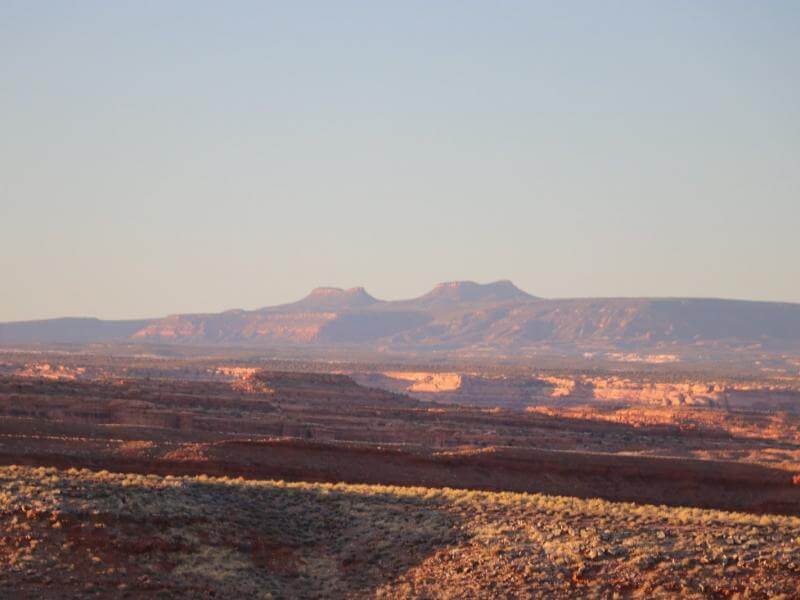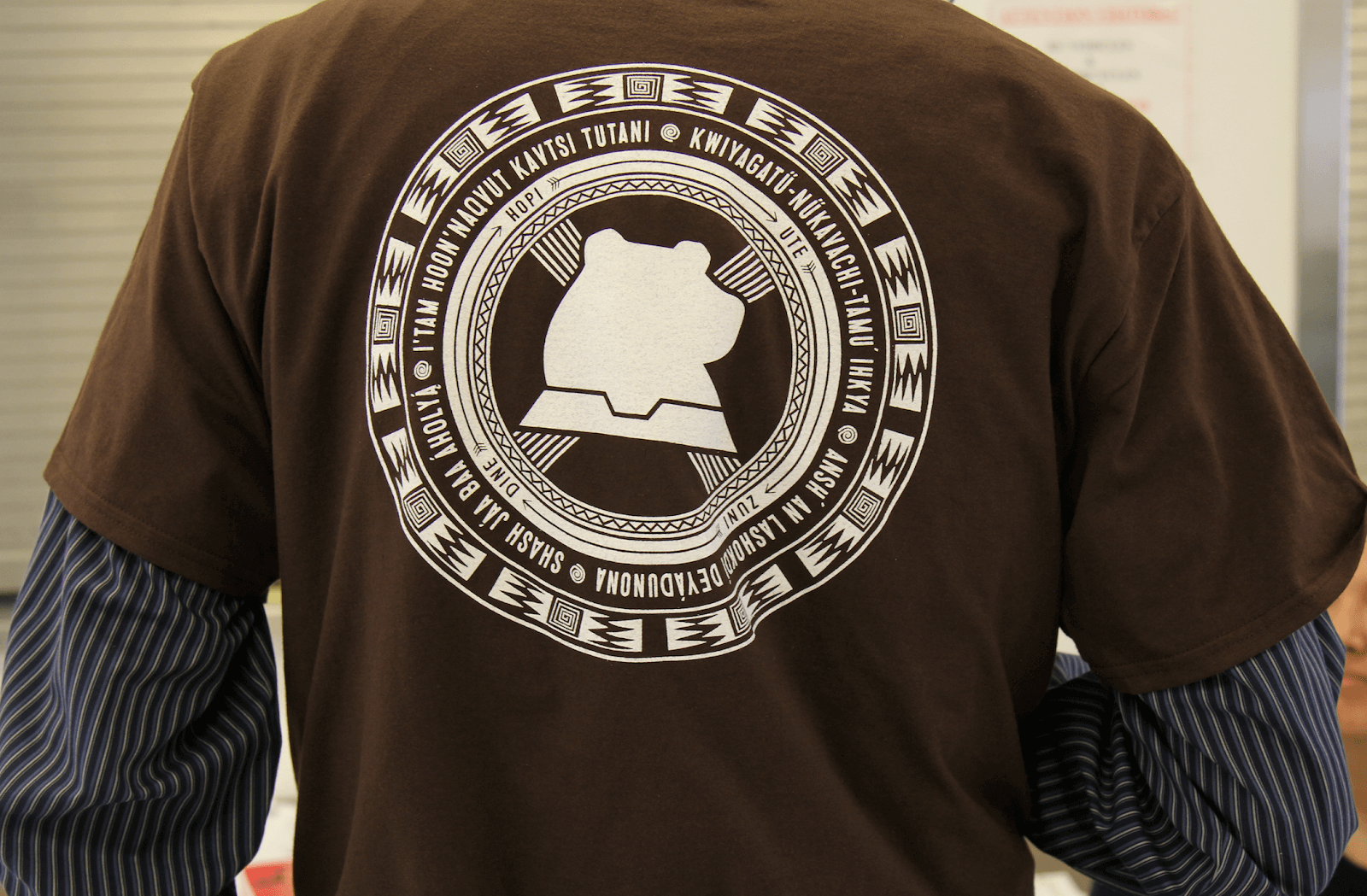Bears Ears is My Wakanda
Angelo Baca
November 25, 2019 | Reflections

Image Credit: Author's own (Angelo Baca 2019)
As an Indigenous person both Navajo and Hopi, Bears Ears is my ancestral land. It is one of the least known parts of the United States, and yet the most heard about in the news in the fight for public lands, national monuments, and protection of Indigenous sacred landscapes. In the southeastern Utah region, Bears Ears National Monument within San Juan County is where many canyons, mountains, and deserts already exist in the American consciousness as the Wild West. This area has been called home by numerous Indigenous peoples, including non-Indigenous communities.
Although the film Black Panther (2018) introduced us to the fictional place in Africa called Wakanda, it also hinted at some fundamentally interesting ideas to mainstream audiences through the Marvel Cinematic Universe and the sizeable comic book archives around it. This article explores parallels between the real place of Bears Ears, which I call home and the fictional place of Wakanda: these two places are hiding in plain sight, have never been “conquered” in any significant settler-colonial context, have their own science and technology practices, and now, are protected by five tribes.
The Bears Ears National Monument, is a good example of tribal sovereignty and coalition-building impacting the development of both land management policy and Native American Civil Rights assisted by Utah Diné Bikéyah, an Indigenous non-profit that helped to formulate the proposal for the monument’s protection. The Inter-Tribal Coalition consisting of five tribes (Diné, Hopi, Zuni, Ute Mountain Ute, and the Ute Indian Tribe) initiated a collective movement uniting historically battling tribes for a singular focus: to protect 1.9 million acres of a sacred Utah landscape called “Bears Ears.” Successfully achieved on December 28, 2016, the National Monument designated 1.35 million acres protected for future generations. In essence, the Bears Ears Inter-Tribal Coalition seeks to work with federal agencies to co-manage this landscape together.
Indigenous African history, science, traditions, and Afro-futurism have made Wakanda a beautiful imagining of the future. Indigenous peoples, here in the Americas, identify and see parallels with their struggles that many communities of color experience daily as well. Some Indigenous scholars frame Wakanda as part of Indigenous Futurisms to survive the present while some African-American scholars counter that Wakanda is an excellent idea but does not exist. What if somewhere like Wakanda did exist for Indigenous people, such as Bears Ears? What if the science and the accumulated knowledge over generations in a place like Bears Ears were allowed to emerge on its own? A place that maintained its trajectory of technological and scientific development unimpeded by settler-colonialism? What would that look like and how would this be a useful exercise?
Parallels between Traditional Knowledge and Vibranium
150 years ago, Russian chemist Dmitry Mendeleev developed the Periodic Table of Chemical Elements, becoming both standardized science and representational of scientific thought. In its orderly organization of chemical properties, it explains chemistry as implicitly ontological in the elemental and universal structure of nature. It’s a recent human-made endeavor in the attempt of categorizing and, in a way, taming the natural world by intellectualizing it into discrete and digestible parts based on the Western scholarly mind. Vibranium, the fictional element known only to exist in Wakanda, has no scientific or natural value on the periodic chart in real-life scientific applications, but that doesn’t mean it isn’t relevant. Science, religion, and spirituality are all different ways of knowing. We cannot discount other ways of knowing because they have their own systems of validity for establishing use and meaning for a variety of people and purposes.
In this framing, Vibranium is a useful metaphor for traditional knowledge, or what some recent incantations of scientific fields have been defining as Traditional Ecological Knowledge, or TEK (See the work of Kimmerer, Carroll, as well as Nelson and Shillings, ed.). Vibranium symbolically represents a variable factor to describe points of science that are difficult to explain using Western knowledge systems alone. Traditional Knowledge, also known as Indigenous science, focuses on landscapes and people developing deep relationships with each other, gathering observational data about a place over thousands of years to understand the delicate ecological balance of that environment. It is often ignored by more recognized scientists and institutions celebrating Western ways of knowing over others. Only the best researchers, scientists, and institutions include traditional knowledge and western academic knowledge together supplementing each other. This complementarity brings balance to both outlooks, giving space to the overall holistic perspective of what is being studied rather than just the compartmentalized sections of examination commonly seen in academia today.
A Return of Ancestral Knowledge
Ancestral sites, or what Western scientists call archaeological sites or ruins, containing solar calendars still accurate today. Knowledge of the cycles of the sun, stars, moon, and the seasons for harvesting and growing crops ruled the days, and still influence how we plant and grow. The solstice calendars and sun daggers are still accurate, telling the story of the cosmos reminding us of our humble place in the universe. Such sites dot the Southwest, and the Ancient Ones had lengthy knowledge of the world, and beyond, in proximate spaces like Chaco Canyon, Mesa Verde, and Bears Ears.
Bears Ears is filled with technology, for example: a newly rediscovered potato of both Grand Escalante Staircase and Bears Ears National Monuments is being brought back from the past to the present. Ancient Puebloans grew and cultivated this potato and still know how. Its existence challenges previously held assumptions of anthropological theories and peopling in the area. According to radiocarbon dating, it appears that this potato was here earlier than anybody had previously anticipated, with its age calculated at more than 11,000 years old. This weakens tightly held perceptions of Indigenous existence in this area, opening up our understandings of their living at Ears Bears to now increasingly earlier times.
When people couldn’t cross the mountains, canyons, or deserts, they then used the rivers as their pathways, the first original roads. Human interaction occurred at these river and canyon wall intersections. When Ancestors came through here, they left the knowledge and archives on the walls. What academic and professional people call rock art, petroglyphs, and Native American symbols, we call timeless stories of who we are and where we came from, perhaps some hints to where we are going. Imagine the Smithsonian archives openly out in the desert winds under the blue skies of the Utah landscape. These are our archives. Yet, the National Monument designation that would protect them from gas, oil, and mining destruction has been recently changed by the Trump Administration from the original 1.35 million acres to about 200,000 acres, an 85% reduction, a move still being challenged in court. These images are direct communications of ancestral knowledge describing the Indigenous and human story of Native science over the centuries.
Shared by Many Tribal Nations
Bears Ears holds so much knowledge that it is impossible to know everything there. When Western scholars talk about the previous inhabitants, they often refer to them as if gone or having mysteriously disappeared. Yet, Pueblo descendants are here from the Hopi and the Zuni communities to the 20 New Mexico Pueblos who claim ancestral heritage with migration narratives of the vast landscape echoing in stories handed down from generation to generation. Many Native nations claim this area, the ancestral home and heart of our people. The heart of early culture beats within Bears Ears; it is alive.
It is also a place of hope. When Kit Carson led the US Army through this area to attack the Navajo Nation, round them up, and take them to Fort Sumner in New Mexico, this scorched earth campaign and genocidal removal became known as the Navajo “Long Walk”. One of the great Navajo headman, also known as Chief Manuelito, lead some Navajo families to Bears Ears to escape the military invasion in their territories. Manuelito knew it as a potential hiding place to evade capture from the invaders. These remote lands protected Navajo families fleeing into this rugged space. Manuelito would go on to help negotiate the Treaty of 1868 for returning Navajo communities back to their lands. Bears Ears hasn’t seen significant settler-colonial violence, a sacred place hardly stained by Western domination or genocide at the hands of non-indigenous outsiders. Bears Ears, hiding in plain sight, also hid our people safely.

Image Credit: Teresa Montoya (Teresa Montoya; March 20, 2016; Bears Ears meeting in Monument Valley, Utah)
Bears Ears is my Wakanda. Traditional Knowledge is my Vibranium. The Bears Ears landscape, unlike Wakanda, is a real place needing our protection. We’re just beginning to understand the deep knowledge this special place holds. It is one of the safest places we have, and if we don’t protect it, Indigenous or not, we lose out on that knowledge and safety. Others who are steeped in Western and linear systems of knowledge are slowly realizing its importance. We have our own heroes, leaders and youth, happy to share them with the rest of the world now. Everyone is about to realize that the best and most cutting-edge research, institutions, and science include both Traditional and Western knowledge – together.
Angelo Baca is a cultural activist, scholar, filmmaker and currently a doctoral student in anthropology at New York University. He is the cultural resources coordinator at Utah Diné Bikéyah, a nonprofit organization dedicated to the defense and protection of culturally significant ancestral lands. The National Parks Conservation Association recently designated him as one of “10 Under 40” dynamic cultural activists who make up the association’s Next Generation Advisory Council. He has published a widely read op-ed in the New York Times. Shash Jaa’: Bears Ears is Angelo Baca’s latest award-winning film about the five tribes of the Bears Ears Inter-Tribal Coalition that worked together to protect 1.9 million acres of Utah wilderness through a national monument designation. His work reflects a long-standing dedication to both Western and Indigenous knowledge.
Published: 11/25/2019
